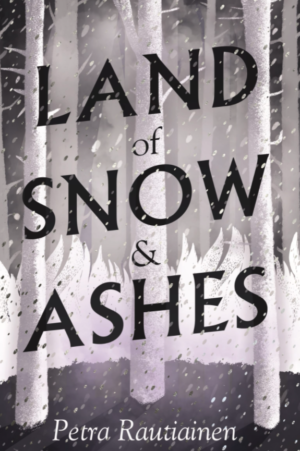Land of Snow and Ashes
by Petra Rautiainen, translated by David Hackston
reviewed by Csilla Toldy
Petra Rautiainen’s debut novel, Land of Snow and Ashes, transports readers to the snowy landscape of Lapland, where we find not the land of myth, but a place filled with memories of genocide. Rautiainen tells the story of Nazi crimes against the Sámi people, setting this novel apart from the plethora of World War II historical fiction.
Translated from the Finnish by David Hackston, Land of Snow and Ashes unfolds on two timelines: one storyline is set in 1944 during the German occupation, shortly before Finland’s peace treaty with Russia; the other takes place five years later when Inkeri, the Finnish protagonist of the novel, visits Lapland. A journalist by trade, Inkeri comes to report on the rebuilding of Lapland and the ongoing attempt to integrate the remaining members of the indigenous Sámi culture into Finnish society—a process initiated with the introduction of Catholicism and education in the seventeenth century, when attempts were made to forcibly settle the Sámi, a nomadic people who herd reindeer. As the old Sámi man, Piera tells Inkeri:
What we had before is in the past now. Of what’s to come, we have only an inkling, if that. That’s what the birds losing their minds really means. The animals know it fine well. They’re not stupid. Animals are far from stupid. It’s us humans that have the tendency for that.
The symbol of this development is Bigga-Marja, Pieri’s grandchild, who has a double name, Finnish and Sámi. She is the key to the narrative, a young girl who has witnessed both the genocide perpetrated by the Nazis and the new Finnish government’s attempts to integrate the Sámi with the help of scientists. There are chilling undertones to the latter endeavor. When “researchers” appear in their village measuring skulls and taking photographs of naked children, Bigga-Marja has flashbacks to the Nazi past and runs away into the life-threatening cold. Her grandfather finds the girl, but her inner exile continues.
Meanwhile, Inkeri is on a quest to find out what happened to her husband, a prisoner of war under the Nazis. Inkeri’s search is helped (and hindered) by a colorful cast of characters, including her lodger Olavi, a Finnish mystery man with a keen interest in botany. Inkeri’s reckoning with the Sámi culture fulfills Rautiainen’s stated goal as an author: “Intercultural communication—how different cultures and individuals face one another—are the main themes of my novels.”
The symbolism of Land of Snow and Ashes hints at this larger goal. Inkeri, a photographer who works with light, wears dark glasses to protect her eyes from the sunlight reflected by the snow. Eyes and eyeballs are an undercurrent in the narrative, which mentions the Nazi doctor Mengele’s “experiments” in creating “Aryan” eyes.
This motif comes to the fore in the novel’s second timeline: a diary written in 1944 by a soldier of unknown allegiance. He is an interpreter and observer of the concentration camp, witnessing the clash of cultures and the atrocities committed there. His entries are spare and unflinching:
A woman arrived with the doctor. I understand she is a shamanistic bloodletter. A witch. Noaidi, in the local tongue. For some reason she is working here as a nurse. She didn’t say anything to us and got straight to work. But I did catch sight of her eyes. They are a strange colour. I have never seen anything like it. I was afraid to look into them but couldn’t help myself. They were like freshly blossomed heath violets or fat bilberries glistening in the morning dew. Not quite blue, but something altogether different.
A hue reflecting the piercing Arctic light and the universe.
Revelations come thick and fast towards the end of the novel. The diarist gradually reveals that the concentration camp is where body parts are harvested for Mengele’s experiments. Inkeri makes the heart-wrenching discovery that her husband Kaarlo—a Finn—was a privileged prisoner cooperating with the Nazis in this endeavor. As the plot unfolds, it becomes clear that the narrator is Kaarlo’s killer, but in a turn of dramatic irony, Inkeri never finds out what happened to her husband, while the reader does. It’s an elegant sleight of hand that beautifully ties together this book’s two timelines.
Despite its heavy subject matter, Land of Snow and Ashes ends on a hopeful note. Inkeri decides to stay in Lapland to immerse herself in the Sámi culture with the help of her assistant, who becomes her “eye”: Bigga-Marja. Rautiainen has given us a beautifully written novel and a thriller that will keep readers turning the page to find out the truth about this disgraceful chapter of Finnish history.
Published on March 24, 2022

